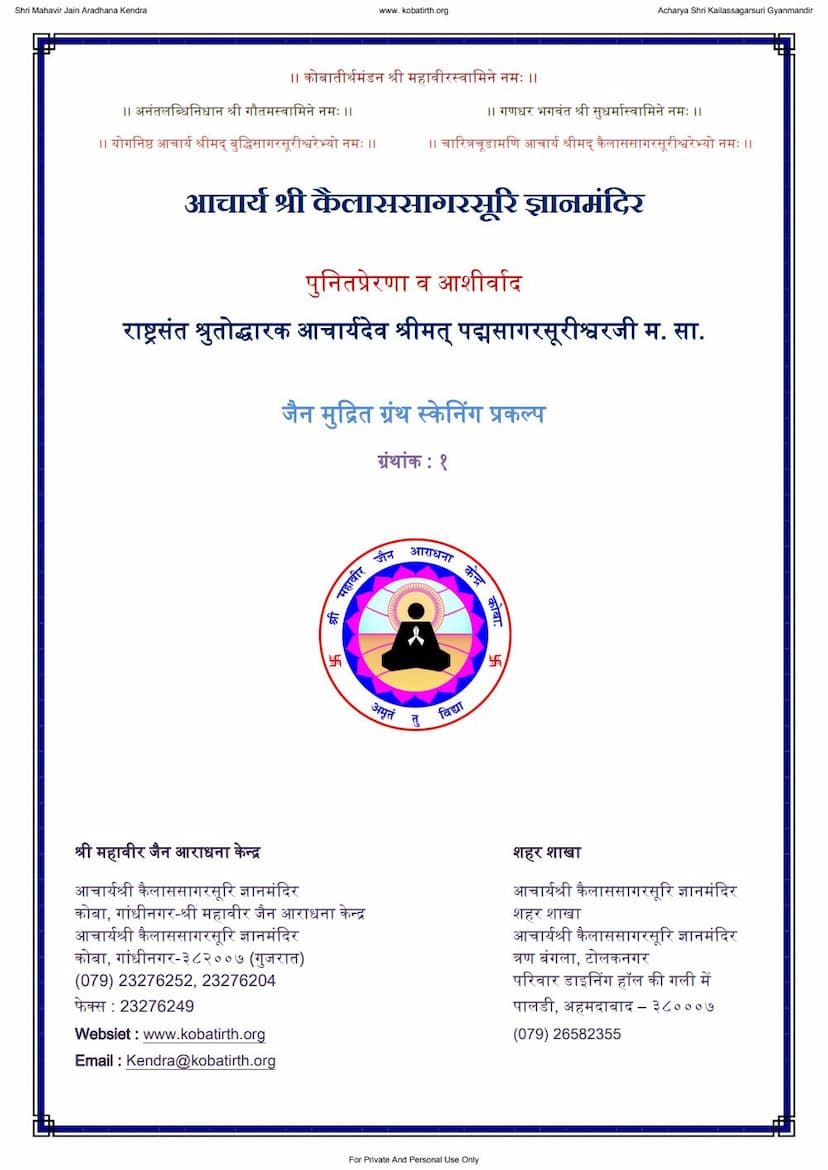Yamdand
Added to library: September 2, 2025

Summary
Here's a comprehensive summary of the Jain text "Yamdand" by Nishkulanand Swami, based on the provided pages:
Title: Yamdand (The Staff of Yama, the Lord of Death) Author: Nishkulanand Swami Publisher: Gondal Swadesh Hitprakash Chapkhanu Catalog Link: https://jainqq.org/explore/020947/1
Overall Theme:
The text "Yamdand" is a spiritual discourse primarily focused on the consequences of actions, particularly the suffering and torment that await individuals in the realms of hell (Naraka) due to their sins. It vividly describes the horrific punishments inflicted upon sinners by the agents of Yama (the Lord of Death) and emphasizes the importance of righteous conduct, devotion to Jain principles, and detachment from worldly pleasures to escape this cycle of suffering. The narrative often uses vivid imagery and emotional appeals to deter individuals from committing sinful acts.
Key Concepts and Content:
- The Power of Yama and His Agents: The text frequently refers to Yama (the Lord of Death) and his formidable attendants (Yamdutas) who are depicted as instruments of divine justice. They are described as powerful, merciless, and relentlessly carrying out punishments on those who have committed sins.
- The Torments of Hell (Naraka): A significant portion of the text is dedicated to detailing the various tortures and agonies experienced by souls in the hellish realms. These descriptions are often graphic and aim to evoke a sense of dread and the dire outcomes of unrighteous living. The text enumerates different types of hellish punishments, often involving extreme heat, cold, pain, and the consumption of disgusting substances.
- Karma and Rebirth: The fundamental Jain principle of Karma is central to "Yamdand." The text emphasizes that one's actions in this life directly determine their future suffering or liberation. Sins accumulate karma that leads to rebirth in lower realms and intense suffering in hell. The cycle of birth, death, and rebirth (Samsara) is presented as a consequence of ignorance and attachment to worldly desires.
- The Cycle of Birth and the Pain of Existence: The text delves into the suffering experienced throughout the cycle of existence, including the painful experience of being in the womb, the difficulties of childhood, the hardships of life, and the inevitability of death. This detailed portrayal highlights the inherent suffering within the realm of Samsara.
- The Importance of Righteous Conduct and Devotion: To escape the tortures of hell and the cycle of rebirth, Nishkulanand Swami stresses the necessity of adhering to Jain ethics. This includes:
- Ahimsa (Non-violence): Avoiding harm to all living beings.
- Truthfulness (Satya): Speaking the truth.
- Non-stealing (Asteya): Not taking what is not given.
- Celibacy/Chastity (Brahmacharya): Controlling desires.
- Non-possession (Aparigraha): Detachment from material possessions.
- Devotion to the Tirthankaras: Particularly Lord Mahavir, and the enlightened beings like Gautam Swami and Sudharma Swami.
- Seeking the guidance of true gurus and saints (Satsang).
- Practicing austerity and penance (Tapas).
- Critique of Worldly Attachments and Sins: The text identifies various worldly attachments and sinful actions that lead to suffering, including:
- Lust and attachment to the opposite sex.
- Greed and desire for wealth.
- Anger and hatred.
- Pride and ego.
- Deception and hypocrisy.
- Violence and cruelty.
- Consumption of meat and other intoxicants.
- Disrespect to parents, gurus, and elders.
- Attachment to family and worldly relationships.
- The Ideal Path to Liberation: The ultimate goal presented is liberation (Moksha), which can be achieved by overcoming ignorance, shedding karma, practicing detachment, and cultivating spiritual knowledge and devotion. The text encourages readers to reflect on the transient nature of life and the ultimate emptiness of worldly pleasures.
- Poetic Style and Language: The text is written in a poetic style, using verses (often in a meter similar to Doha or Chaupai) to convey its spiritual message. The language, though in Gujarati script, aims to be accessible and impactful for devotees.
Structure (Inferred from the page numbers):
The text appears to be structured in a series of chapters or sections, possibly introduced by "Kadva" (couplets or stanzas) and "Chopai" (quatrains). The numbering of these sections and the recurring use of phrases like "Purva khayo" (previously spoken) suggest a narrative or didactic flow, building upon previous teachings.
In essence, "Yamdand" serves as a potent spiritual warning and a guide. It paints a stark picture of the consequences of a life lived without ethical consideration and divine devotion, while simultaneously offering a clear path towards spiritual liberation through adherence to Jain principles and unwavering faith.